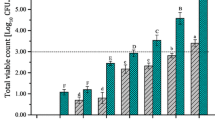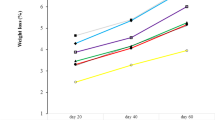Abstract
Studies were carried out with an objective to assess the effect of various post harvest treatments with chemical preservative, ionizing radiation doses and low temperature (LT) storage on the storability and the microbial quality of the grape pomace and retention of anthocyanins in it. The grape pomace collected after processing of fully matured grape berries (var.Bangalore blue) was treated with 0.1% sodium benzoate(0.1% SB), packed and sealed in LDPE film pouches and exposed to γ-irradiation(0, 2, 4 and 6 kGy) and stored along with untreated control at LT (4 ± 1 °C, 90–95% RH)conditions. During storage, changes in physico-chemical and microbial quality attributes of these treated grape pomace were recorded. Among the treatments, combination of 0.1% sodium benzoate and 2.0 kGy dose of γ-irradiation (0.1% SB +2.0 kGy) was found to be more effective in improving the storability of grape pomace and in retention anthocyanins (34.70 mg/100 g) during storage. The storage life of above treated grape pomace stored at LT could be extended up to 16 days as compared to 8 days of control grape pomace (31.8 mg/100 g). Results on microbiological studies indicated that 0.1% SB +2.0 kGy reduced the total aerobic bacterial count (1.4 log CFU/g) and the yeast and mould count (1.6 log CFU/g) in the treated grape pomace during 16 days of storage as compared to the total aerobic bacterial count (6.5 log CFU/g) and the yeast and mould count (6.3 log CFU/g) in control. Sodium benzoate and low irradiation (0.1% SB +2.0 kGy) was significant in controlling the multiplication of coliforms in grape pomace during LT storage and thus finds potential for commercial application in ensuring the microbiological safety and quality of grape pomace during its bulk storage at low temperature (4 ± 1 °C; 90–95% RH) conditions. This preservation method could be used by the wine making industries for bulk storage of grape pomace after processing of colored grapes during peak harvesting season for further end uses.


Similar content being viewed by others
References
Ayed N, Yu HL, Lacroix M (1999) Improvement of anthocyanin yield and shelf life extension of grape pomace by gamma irradiation. Food Res Int 32(8):539–543
Beaulieu M, Beliveau G, D’Aprano G, Lacroix M (1999) Dose rate effect of gamma irradiation on phenolic compounds, polyphenol oxidase (PPO) and browning of mushrooms Agaricus bisporus. J Agric Food Chem 47:2537–2543
Bridle P, Timberlake CF (1997) Anthocyanins as natural food colours selected aspects. Food Chem 58(1–2):103–109
Cantos E, Espin JC, Tomas Barberan FA (2002) Varietal differences among the polyphenol profiles of seven table grape cultivars studied by LC-DAD-MS-MS. J Agric Food Chem 50(20):5691–5696
Couture R, Willemot C (1989) Combination d’une faible dose of radiation avec l’atmosphre controlee pour ralentir le murissement defraises. In: Reid DS Technological innovation in freezing and refrigeration of fruits and vegetables. CA:UC Davis. pp. 67–72
FAO Statistical Database (2004) http://www.fao.org (20-11-2005)
FAO Statistical Database (2005) http://www.fao.org (23-2-2006)
Farkas J (2006) Irradiation for better foods. J Trends Food Sci Technol 20:1–5
Hunter S (1975) The measurement of appearance. John Wiley and Sons. New York, pp 304–305
Kamat A, Pingulkar K, Bhushan B, Gholap A, Thomas P (2003) Potential application of low dose gamma irradiation to improve the microbiological safety of fresh coriander leaves. Food Control 14:529–537
Kammerer D, Claus A, Carle R, Scieber A (2004) Polyphenol screening of pomace from red to white grape varieties (Vitis vinifera) by HPLC-DAD-MS/MS. J Agric Food Chem 52(14):4360–4367
Koorapati A, Foley D, Pilling R, Prakash A (2004) Electron—beam irradiation preserves the quality of white button mushroom (Agaricus bisporus) slices. J Food Sci 69(1):25–29
Kwon JH, Belanger JMR, Sigouin M, Lanthier J, Willemot PJRJ (1993) Chemical constituents of Panax ginseng exposed to γ irradiation. J Agric Food Chem 38:830–834
Mahajan BVC, Dhatt AS, Satish K, Manohar L (2009) Studies on cool storage of grapes for extended marketability. J Food Sci Technol 46(4):363–366
Neall B (2003) Amazing grapes. Food Rev 30(10):35–38
Oufedjikh H, Mahrouz M, Lacroix M, Amiot MJ, Taccini M (1998) The influence of gamma irradiation on flavonoids content during storage or irradiated clementina. Rad Phys Chem 52:107–112
Patil NS, Kotecha PM, Chavan JK (2007) Wine making quality of different grape cultivars. J Food Sci Technol 44(2):125–126
PFA (1955) Prevention of Food Adultration Act, 1954 Rules, 19th edn. International Law Book Co, Delhi, p 140
Pina CG. de, Hogg TA (1999) Microbial and chemical changes during the spontaneous ensilage of grape pomace. J Appl Microbiol 86(5):777–784
Prabhakara Rao PG, Balaswamy K, Velu V, Jyothirmayi T, Satyanarayana A (2009) Products from grapes of low soluble solids to their quality evaluation. J Food Sci Technol 46(1):77–79
Ranganna S (1986) Handbook of analysis and quality control for fruits and vegetables, 2nd edn. McGraw Hill Publishing Co. Ltd, New Delhi
SAS (1985) SAS /SAT user’s guide, Statistics version 5th edn. SAS Institute, Cary, NC, USA
Singleton VL, Esau P (1969) Advances in food research (supplement I). Academic, New York
WHO (1994) Safety and nutritional adequacy of irradiated food, Geneva
Srivastava RP, Sanjeev K (1993) Principles and methods of preservation. In: Fruit and vegetable preservation-principles and practices, 2nd edn. International Book Distributing Co, Lucknow, India, pp 88–109
Acknowledgement
Authors are grateful to Prakash V, Director, CFTRI, and Mysore for his keen interest, constant encouragement and support during the course of this investigation. Authors extend their sincere thanks to Rajarathnam S Head, Department of Fruit and Vegetable Technology for his constant encouragement and guidance during the course of investigation.
Author information
Authors and Affiliations
Corresponding author
Rights and permissions
About this article
Cite this article
Augustine, S., Kudachikar, V.B., Vanajakshi, V. et al. Effect of combined preservation techniques on the stability and microbial quality and retention of anthocyanins in grape pomace stored at low temperature. J Food Sci Technol 50, 332–338 (2013). https://doi.org/10.1007/s13197-011-0325-0
Revised:
Accepted:
Published:
Issue Date:
DOI: https://doi.org/10.1007/s13197-011-0325-0




